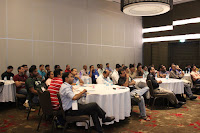Below are the details of the talk:
Abstract
In a fast-moving environment, where Continuous Integration (CI) and Continuous Delivery (CD) are a necessity and not a luxury, how can teams decide if a product is ready to be deployed to the next environment and go 'live'?What is the health of your product portfolio at any point in time?
Can you identify patterns over a period of time in making better decisions to better the quality of your product(s)?
Test Automation across all layers of the Test Pyramid enables to get quick feedback about the health of the product-under-test.
However, in an organization having multiple products in its portfolio, how can you get the collated quality / health information from all the products, quickly and in real-time? Or, for a large program of work, which has various projects being worked on in parallel by numerous teams across the world, how can the relevant people quickly get the consolidated quality / health information for the whole program?
In such cases, how can you:
- figure out any Trends / Patterns in the quality, or,
- do any meaningful Comparative Analysis (say between the quality of last release Vs the next release), or,
- do quick Failure Analysis and prioritize the 'fixing' of issues in an efficient fashion, and,
- do some quick Functional Performance Benchmarking.
At present this needs to be done manually.
Learn an effective way to answer the above questions - with TTA (Test Trend Analyzer), an open source product.
TTA give you real-time and visual insights into the health of the product portfolio using the Test Automation results. This allows teams to take decisions on the product deployment to the next level using actual data points, instead of 'gut-feel' based decisions.
Slides from the talk
To Deploy or Not-To-Deploy - decide using TTA's Trend & Failure Analysis from Anand Bagmar
Some pictures from the conference
To Deploy or Not-To-Deploy - decide using TTA's Trend & Failure Analysis from Anand Bagmar












